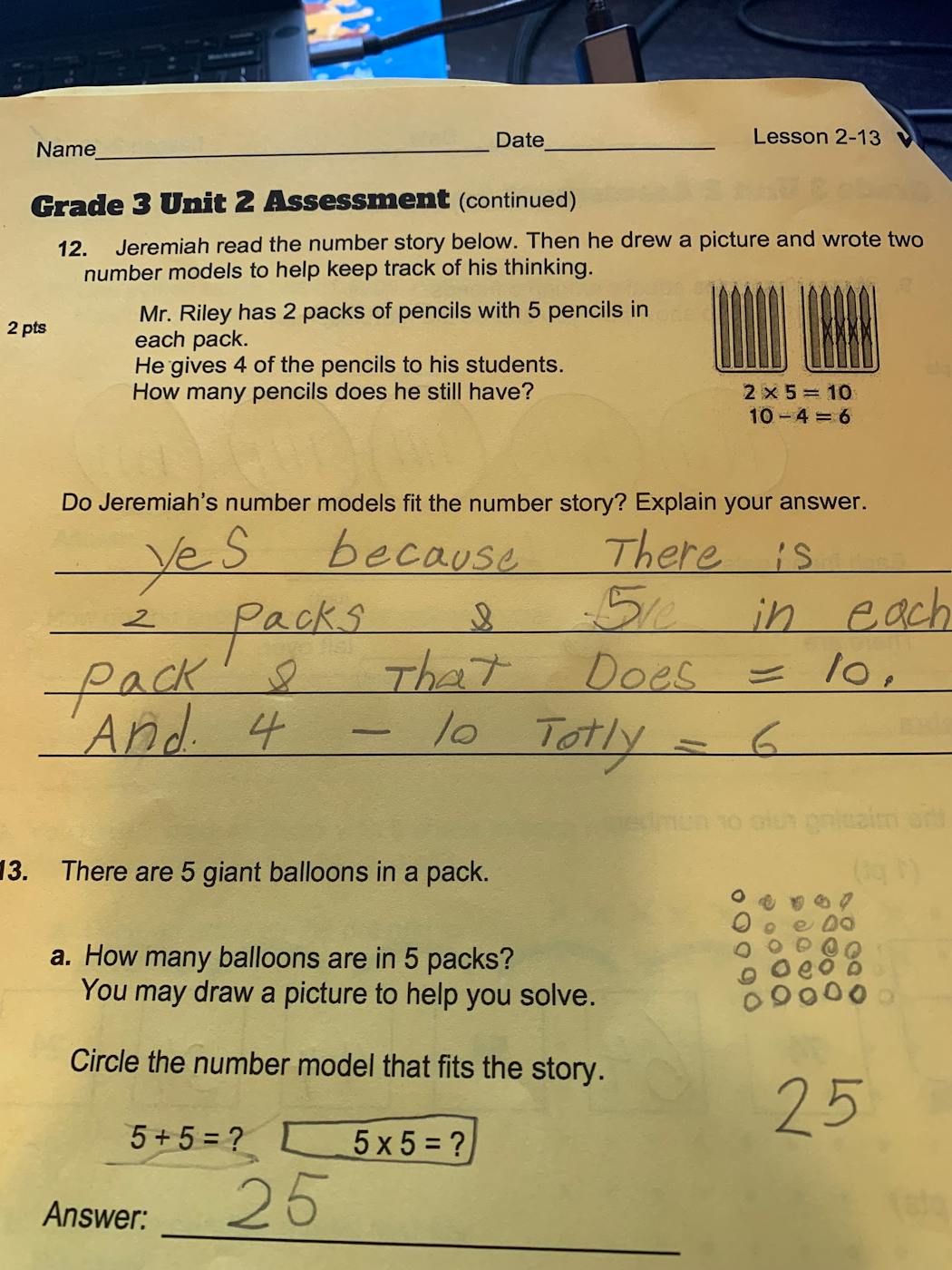The kids are doing 'new math,' and maybe that's a good thing
A math handout sent home by teachers at my son's school struck me as so absurd that I thought for sure the parents were getting punked.
The exercise demonstrated how to do the new way of long division. Not the way I learned, which was determining how many times the little number goes into the big number, digit by digit — the most direct route to arrive at the answer.
The era of new math suggests that fourth-graders take various stabs and turns, throwing quotient spaghetti against the wall, and scribbling down their meanderings across a half-page of paper to get to the same result.
For example, if I were asked to divide 358 by 4, I could calculate the quotient in a few efficient steps — that is, after I remember how to do long division. (The answer is 89 with a remainder of 2.) But these days, a student is encouraged to think: How many times can 4 go into 358? Hmm, let's try 50.
4 x 50 = 200
358 - 200 = 158
We still have 158 leftover. How many times can 4 go into 158? Let's try 20.
4 x 20 = 80
158 - 80 = 78
Now we have 78 left. How many times can 4 go into 78? What happens if we try 10?
4 x 10 = 40
78 - 40 = 38
How many times does 4 go into 38? That's easy: 9.
4 x 9 = 36
38 - 36 = 2
Now we add up all the quotients.
50 + 20 + 10 + 9 = 89, with 2 remaining.
Same answer. But instead of a straight-line path to our destination, we treated ourselves to a picnic lunch, stretched our legs at a national park, snapped selfies in front of a waterfall, made a Target run, and took five bathroom breaks along the way.
So, I cackled when I saw the handout. Yet moments later it dawned on me that my 9-year-old is starting to surpass me on other kinds of calculations he can do in his head. Maybe it's because of new math.
Old math emphasized rote memorization of formulas and shortcuts. As kids, my generation was taught to "carry" and "borrow" numbers, often without explanation of the reasoning behind it. New math teaches math conceptually and gives students multiple ways to solve a problem.
After students absorb the concepts, the goal is to then show them the standard algorithms of our youth, says Minneapolis middle school teacher Jodie Rose-Harkness. What many teachers are now embracing is a blend of old and new math.
"The big reason why new math exists is because in the past, people learned procedures and didn't always understand why: 'Here's the rule. Learn the rule,' " Rose-Harkness said. "People know procedures, but they don't understand math. We're trying to change that."
New math isn't actually new. A version of it can be traced to the 1950s after the Soviets launched Sputnik and American lawmakers panicked that we weren't teaching enough math and science. But like so many trends in education, the pendulum has swung back and forth, between teaching conceptual math and "back to the basics." Parents, and even some teachers, can be the loudest critics of new math because it's so far afield of how we learned it.
"There's a lot of emotions that people hold inside, because math made them feel either very brilliant or completely stupid," said James Brickwedde, a former Hopkins Public Schools teacher who provides professional development support for teachers in math education. "Mathematics really does stimulate a lot of passion."
For years I have been baffled by how my kid was learning math in school and felt powerless to help him. I tried to drill him with flashcards and drew up a multiplication table on a giant white board, but he wasn't as interested in memorizing math facts. For his class assignments, he spent a lot of time shading in pies and square grids and was frequently told to "show your work." Most parents have probably seen worksheets that ask their children to use words explaining how they arrived at the solution. "I just no (sic)" is a common response (though unacceptable by most teachers' standards).
But as early as first grade, my son would demonstrate flickers of true mathematical insight. If the problem was 34 + 52, he would not line them up in neat rows and add each digit vertically like I would. He would tell me, "30 + 50 is 80, and 4 + 2 is 6, so the answer is 86."
Now that he's multiplying large numbers, I often find myself asking: How did you do that? Even though I excelled in math throughout elementary school (I have fond memories of dominating my first-grade class in the flashcard game Around the World) the methods I learned for more advanced computations, such as adding fractions, sometimes elude my 45-year-old brain.
"If your memory is gone, does that mean you're no longer good at math?" said Lesa Clarkson, a professor of mathematics education at the University of Minnesota. "Or does it mean you were good at memorizing, as opposed to being good at math?"
Honestly, I think I was just good at memorizing. The wheels started to fall off in high school, where I dropped out of calculus in my senior year. Brickwedde said it's common for children to slip in math as they age out of grade school because they don't have a solid foundation of mathematical concepts.
"They get to middle school and the house of cards of tricks that were built for them through elementary school do not sustain into the levels of mathematics that they have to do," Brickwedde said.
He also lit up when I showed him the handout on partial quotients division. Yes, it looks tedious, but as their sense of numbers grows, students will be able to complete the exercise with far fewer steps, he said.
Educators are playing a long game, encouraged by research suggesting that a mix of strategies can deepen students' mathematical knowledge and help them think creatively about solutions. Countries that tend to outperform the U.S. on international math assessments — including Finland, the Netherlands and Japan — tend to teach more flexible problem-solving skills, he said.
And we need our kids to grow up to be problem-solvers, not human calculators. We won't enter the next era of space exploration or nanotechnology by memorization alone. Even shop floor staffers in manufacturing plants "need a level of mathematical thinking that is different from classic assembly-line workers," Brickwedde said, noting the evolution of the global workplace.
I'm slowly coming around to seeing the benefits of new math. Being a parent means you dream a little bigger for your kid, and I hope my son's inquisitive mind will keep finding delight and awe in a subject that soured with me over time. Maybe new math can be a path to a lifelong passion for STEM.
So I've stopped cackling over partial quotients. But I haven't thrown out the flashcards.


